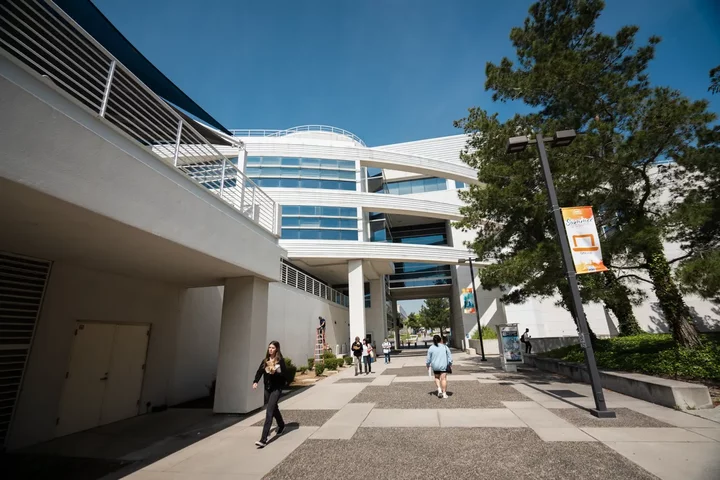The CSU San Bernardino campus on April 22, 2024. Photo by Jules Hotz for CalMatters
###
This story was originally published by CalMatters. Sign up for their newsletters.
###
A lawsuit recently filed in Tennessee could affect colleges that serve large numbers of Latino students in the Inland Empire and throughout California, including Cal Poly Humboldt.
Students for Fair Admissions, the national group whose lawsuit resulted in the US Supreme Court striking down affirmative action in college admissions, has joined a lawsuit recently filed by Tennessee’s attorney general against the U.S Department of Education.
The lawsuit says the education department’s special funding for programs targeting “Hispanic-Serving Institutions” is discriminatory and unconstitutional.
Hispanic-Serving Institutions are colleges and universities where 25% or more undergraduates are Latino and a large share of the students are low income. The program is designed to help colleges and universities attract and support Latinos and other disadvantaged students.
National studies show Latinos are more likely than non-Hispanic white people to be first-generation college students and to face financial, linguistic, and cultural barriers to higher education.
The Hispanic serving program has grown exponentially since federal laws created it in 1992. The education department in 2023 spent $418.8 million on grants and assistance to colleges that qualified. They used the money for labs, libraries, tutors, student service programs, scholarships, fellowships, remote learning and other things. Special grants also support Latino students majoring in science, technology, engineering and math fields.
California has the most Hispanic-serving colleges — 171 of the 615 in the United States — including most Cal State and University of California campuses. About nine in 10 Latino students in California attend Hispanic-serving institutions.
Most of the Inland Empire’s colleges and community colleges are Hispanic-serving, including Cal State San Bernardino, which reported 72% of its undergraduates are Latino, and Riverside Community College, where 68% of its students are Latino.
Taken together, Riverside’s three community college campuses are the largest Hispanic-serving institution, with more than 59,000 students, said Wolde-Ab Isaac, chancellor of the community college district. The federal government sends it $3 million to $4 million a year through the Hispanic-serving program, but that’s only about 1% of its more than $300 million budget.
Without it, the district would find a way to still provide the same services, he said, because that is part of the college’s mission.
“We are serving the underserved. Our populations are educationally and economically underserved,” Isaac said. “This is a system failure … We have a category of our people that have been deprived over many years of neglect, creating generational gaps, both in terms of economic inequalities, social inequalities, health disparities.”
Targeting funding to colleges that provide them with extra support and services is fair, he said.
The Inland Empire is one of the few regions in California where high school enrollments and graduating classes are increasing, he added, but the region also has some of the lowest college-going and college graduation rates in the state.
“We have the most dynamic, the most diverse, the most vibrant population of any (college) and we have a much bigger share of poverty in our areas,” he said. “We have so many young kids compared to any place else and yet those opportunities are not there to help them unlock those talents.”
Hispanic-serving institutions operate in 30 states. Tennessee is suing because none of its colleges has that designation. The lawsuit notes that Tennessee’s colleges have enrolled Latino students, but they fall beneath the 25% threshold.
“To be sure, all Tennessee colleges and universities serve Hispanic students,” the suit states. “They also serve needy, low-income students of all ethnicities. But under the statute, they get no HSI money because they lack enough members of one particular ethnic group. So all students at these schools suffer.”

CLICK TO MANAGE